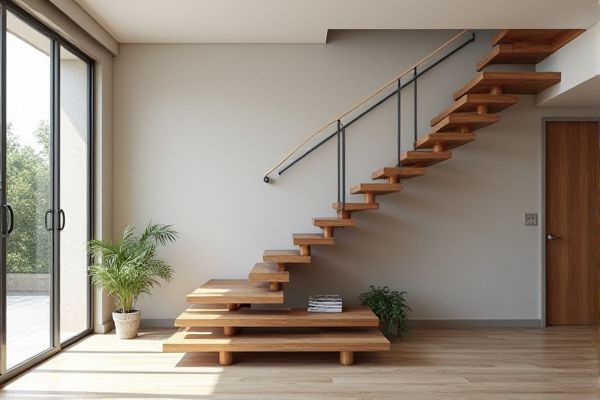
Floating staircases offer a modern, minimalist design with open risers that create a sense of space and light, while traditional staircases provide a classic, sturdy structure with enclosed steps and more intricate detailing. Discover which option best suits your home's style and functionality by reading the rest of the article.
Table of Comparison
| Feature | Floating Staircase | Traditional Staircase |
|---|---|---|
| Design Style | Modern, minimalist | Classic, conventional |
| Structural Support | Hidden or wall-mounted supports | Visible stringers and risers |
| Visual Impact | Open, airy, sleek appearance | Solid, enclosed look |
| Space Efficiency | Maximizes open space | Consumes more floor area |
| Installation Complexity | High; requires precise engineering | Moderate; standardized methods |
| Cost | Generally higher due to design and materials | More affordable with common materials |
| Safety | Needs careful guardrail design | Typically safer with enclosed steps |
| Maintenance | Easy cleaning due to open design | More prone to dirt buildup in enclosed areas |
| Customization | High; materials include glass, steel, wood | Varies; mostly wood, metal with limited styles |
Introduction to Floating and Traditional Staircases
Floating staircases feature open risers and minimal structural support, creating a modern, airy aesthetic that enhances natural light flow in your space. Traditional staircases rely on solid stringers and closed risers, offering a more classic, sturdy design that complements conventional interiors. Choosing between floating and traditional staircases affects your home's style, space perception, and overall architectural appeal.
Aesthetic Appeal: Modern vs Classic Design
Floating staircases offer a sleek, modern aesthetic characterized by open risers and minimalistic support structures, creating a sense of spaciousness and contemporary elegance. Traditional staircases emphasize classic design elements such as solid wood construction, detailed balusters, and closed risers, providing a timeless and sturdy appearance. The choice between floating and traditional staircases fundamentally influences the visual impact of interior spaces, aligning with either modern or classic design preferences.
Space-Saving Benefits and Limitations
Floating staircases offer significant space-saving benefits by eliminating bulky stringers and allowing open risers, creating an airy, minimalist look that enhances room openness and maximizes usable floor space. Traditional staircases typically require more structural support and enclosed risers, which can consume valuable square footage and make areas feel cramped. However, floating designs may have limitations in storage options and structural constraints, making traditional staircases more suitable for homes needing under-stair storage or strict building codes.
Structural Integrity and Safety Considerations
Floating staircases rely on reinforced steel supports and cantilevered steps anchored securely into load-bearing walls to ensure structural integrity, requiring precise engineering to maintain safety. Traditional staircases typically distribute weight evenly through stringers and risers, providing inherent stability and robustness for heavy foot traffic. Safety considerations for floating stairs include slip-resistant materials and guardrails due to open riser designs, while traditional stairs often come with closed risers and handrails offering more enclosed support.
Material Choices and Durability
Floating staircases commonly utilize materials like glass, steel, and hardwood that combine aesthetic transparency with structural strength, enhancing modern interior designs while ensuring durability. Traditional staircases often rely on solid wood, concrete, or wrought iron, offering robust and time-tested construction celebrated for longevity and classic appeal. Material selection in floating staircases emphasizes lightweight engineering and corrosion resistance, whereas traditional stairs prioritize load-bearing capacity and maintenance ease.
Installation Process and Complexity
Floating staircases require specialized installation with hidden supports and precise engineering to ensure structural integrity, often involving custom fabrication and skilled labor. Traditional staircases have a more straightforward installation process, relying on visible stringers and risers, making them easier and quicker to assemble. The complexity of floating staircases typically results in higher installation costs and longer timelines compared to conventional designs.
Cost Comparison: Upfront and Long-Term
Floating staircases typically incur higher upfront costs due to complex materials and installation processes, including steel or reinforced glass components. Traditional staircases often present lower initial expenses, utilizing common materials like wood or concrete with straightforward construction. Long-term maintenance costs for floating staircases can exceed those of traditional ones due to specialized cleaning and potential structural inspections, while traditional designs benefit from durable, low-maintenance materials.
Maintenance and Cleaning Requirements
Floating staircases require less frequent cleaning due to their open design, which reduces dust accumulation on treads and risers. Traditional staircases often have enclosed structures that trap dirt and require more detailed scrubbing and dusting, especially in corners and beneath handrails. You can simplify maintenance with floating staircases by using microfiber cloths and mild cleaners to keep surfaces looking pristine without much effort.
Resale Value and Market Appeal
Floating staircases enhance resale value by offering a modern, visually striking design that appeals to contemporary homebuyers seeking unique architectural features. Traditional staircases attract a broader market due to their classic, timeless appeal and familiarity, which can be a safer investment in conservative housing markets. Homes with floating staircases often stand out in listings, potentially increasing market appeal among younger or design-focused buyers.
Choosing the Right Staircase for Your Home
Floating staircases offer a modern, minimalist aesthetic with open risers that create a sense of spaciousness, making them ideal for contemporary homes with ample natural light. Traditional staircases provide a classic, sturdy design with closed risers and solid railings, offering enhanced privacy and safety, which is suitable for families with children or pets. When choosing the right staircase for your home, consider factors like design preferences, space availability, structural support, and long-term maintenance requirements.
 homyna.com
homyna.com